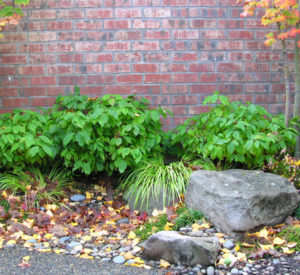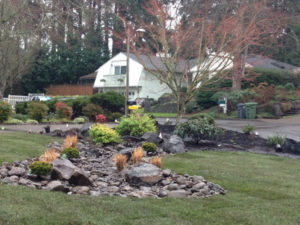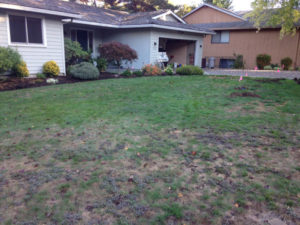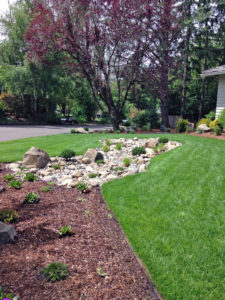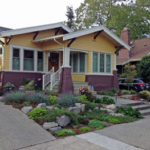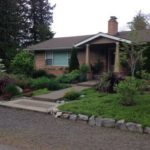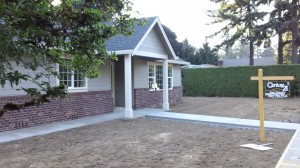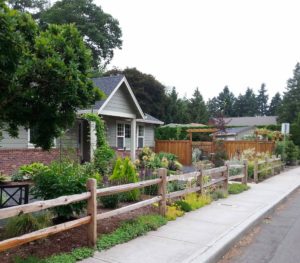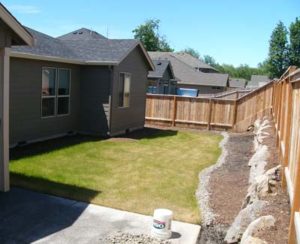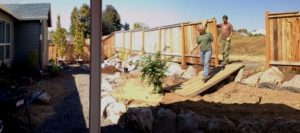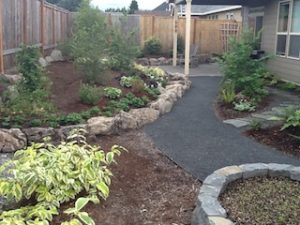Oregon Hillside Residential Landscape Design
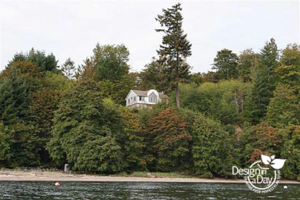
My vacation home is above a steep slope. It’s smart to learn about preventing erosion
Controlling Erosion on Hillsides
As a Portland landscape designer I often work with hillside properties.
I also own a vacation home on Harstine Island in Mason County, Washington. We built our house about 10 years ago. The house is 30 feet from a steep hill overlooking the beach. The things I’ve learned about controlling erosion are useful to anyone who has a sloped property.
When we built the house we made some smart choices, we went with a natural landscape instead of lawn, ran our water from downspouts down the hill in pipes rather than spilling it out at the top of the hill. Nor did we disconnect our downspouts to let water pool and perc down into the soil near the house. That can be a fine practice for flat properties but not hilly ones.
I have a majestic fir tree on my slope and neighbors have suggested I cut it down for fear that it will remove a lot of my bank someday when it fails. I want to support this tree for as long as possible so I was inspired to make an appointment with Karin Strelioff with Mason County Conservation District. Karin is a technician with their Marine Waterfront Assistance Program. She knows about the slopes and cliffs that make the shoreline of the South Puget Sound and many methods of erosion control. She gave me some important signs to watch for regarding my tree and the name of a local arborist who is astute in the science of trees on slopes.

My slope is well planted with salal, sword fern and other erosion controlling native plants.
My Tree
Karin gave me these basic things to watch for with regards to my beautiful huge fir tree.
Pay attention to the surface soil and the plantings around the trees trunk. Know what the ground and general area looks like typically and watch for any changes in that area. On the uphill side of my tree trunk I’ll look for an area of disturbance, an area of soil higher than it was when I saw it last. This could mean my trees roots are pushing toward the surface. On the downhill side of my trunk I will be looking for soil that may have fallen away making a new steeper area. Either one of these disturbances will have me on the phone to an experienced certified arborist that I trust. I love knowing what to look for. It will help me with my anxiety when the wind blows and my tree’s branches whistle like a Hitchcock movie sound track.
I recognize that my tree is supposed to fail at some point, falling down the hill along with a portion of my slope to bring more sand to the beach and add to the natural beachhead. Given that I would like to keep every square inch of my backyard, when the tree is starting to fail, the arborist will probably recommend it be removed. Hopefully by that time I will have enough plant material well established to offset its loss to my erosion control plantings.
Erosion Prevention
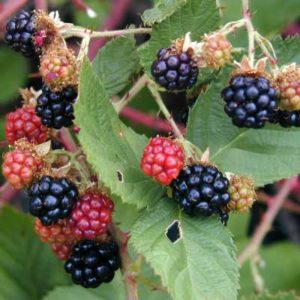
How can anything so sweet, be so evil?
I learned important things about my property. For one thing my various slopes and banks have either a lot of trees or ground covering plants or both so I can take the information from Karin and apply it as a preventative rather than having to rush into a mitigation process. We also have very few invasive plants on the property. I have one Himalayan blackberry plant that we will work on getting rid of. Lucky me.
Karin says the most important thing that I can do is to learn about the water load on my property and how best to control where it goes. The biggest water load source is water from the roof of the house. The county had good rules in place when we built the house so we are also ahead here. We took our water down the hill in pipes. The old practice of disconnecting our downspouts and letting the water perc down a slope has caused erosion problems for many properties. That’s a fine practice for people with flat lots in Portland, in fact Portland encourages disconnecting downspouts and building rain gardens. Karin says be sure to inspect your pipe. If we had a crack or damage to a pipe that allowed water out in the wrong place, it could create a heavy water load and cause big problems. We can start inspecting pretty easily because our pipes are not buried.
Other sources of water are as simple as rain water. The way to control rain water is with plants. Think of it this way………..Gravy and bread. We use bread to sop up the gravy, well we did until they said it was bad for us and now they are saying animal fats are good for us……. I love gravy which is a diversion from this article, must be dinner time. We will use the right plants in the right places to sop up the rain water.
Evergreen trees are most effective on slopes and yet a lot of people cut down evergreen trees because they spoil the view. It turns out evergreen needled trees (coniferous) perform brilliantly to protect slopes from erosion. I had no idea. Here’s why:
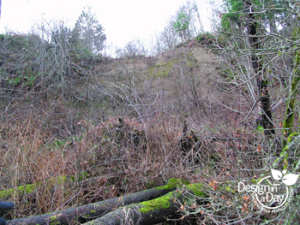
This cliff is feeding sand to the beach.
Large evergreen coniferous trees like our Western Red Cedar or our Douglas Fir have needled foliage. The needles break the impact of hard pelting winter rain into tiny droplets. The surface soil is protected from the impact of the hard rain. That’s helpful, but even better the trees roots take up a tremendous amount of water and utilize a process called transpiration which releases the water from the needles as a fine mist. So water under the soil surface is absorbed by the roots instead of spilling out of the side of the cliff. Deciduous large trees such as Oregon Bigleaf Maple, or alders have no leaves in the winter, and they are dormant and so their roots do not take up as much water as the needled trees do in winter or any other time of the year. The conifir reigns as the top water catcher on the slope. There is also what seems to me to be a rather magical thing fir trees do. It’s called thigmomorphogenesis. This word refers to the way trees and plants respond to mechanical stimuli that influences how they can grow in really unusual ways. Basically, they are responding to the situation on the slope and growing their roots in ways to protect that slope. They may grow a larger branch to balance their mass. Somehow they know to do this. It’s seriously cool science stuff here.
Here’s what I’m going to do to help protect my slope.
New plantings that include evergreen coniferous trees.
First I am going to enhance the soil above my big tree to help the native plants spread and grow. I’ll add compost near my top of slope plantings to try to cajole them into growing toward the house. The top of this hill was graded flat by the developer to build the house so there isn’t a drop of top soil in my flat yard. The native plants stop growing and you can see the straight line across the edge of my yard at the top of the steep downhill slope.
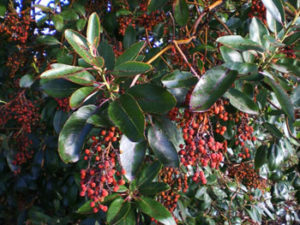
Pacific Madrone – Arbutus menziesii
has recently been approved for City of Portland street trees. It’s a NW native plant.
I am going to plant 3 more (tiny sized) Pacific Madrone below my big fir tree and also 5 dwarf Western Red Cedar. I’ll use willow stakes in areas with more sun. They are easy to plant. I’m using a modified native tree to try to protect my view. The Excelsor Western Red Cedar matures at about 20′ tall, not 70’. Will I be here to see them at 20’ tall? Hard to say, I better keep eating lots of grass fed butter and Kale.
I got so much from my appointment with Karin that I have another blog that will explain what plants I am planting where. Stay tuned for part two.
If you have problems with erosion or a hillside in need of planting, contact me for a residential landscape appointment.

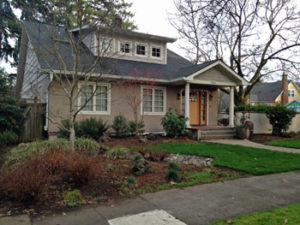
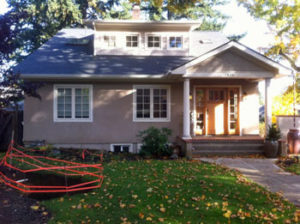 one big problem which wasn’t apparent at the time of purchase and might not have been bothersome if the house was in Arizona. Water!!! Water in the basement, and large puddles of winter rain water in the front yard drowned plants and lawn alike. As the years passed the problem worsened.
one big problem which wasn’t apparent at the time of purchase and might not have been bothersome if the house was in Arizona. Water!!! Water in the basement, and large puddles of winter rain water in the front yard drowned plants and lawn alike. As the years passed the problem worsened.